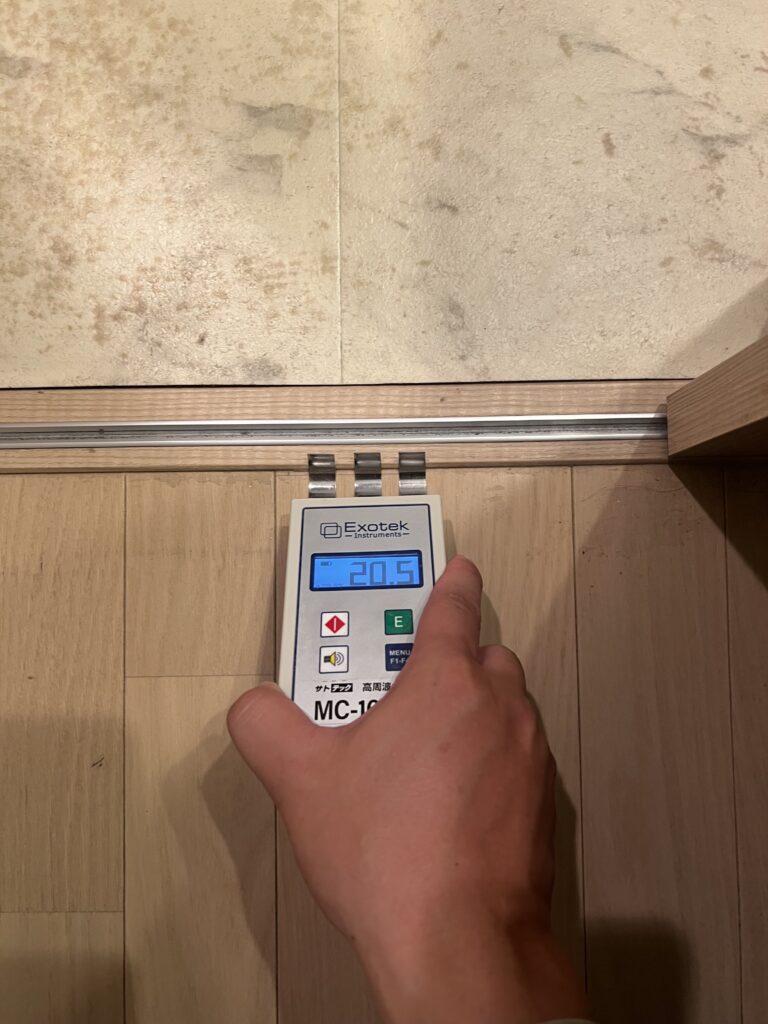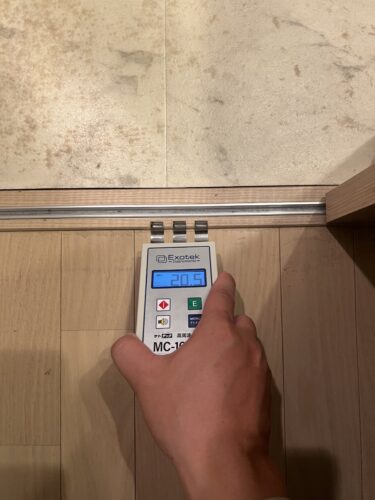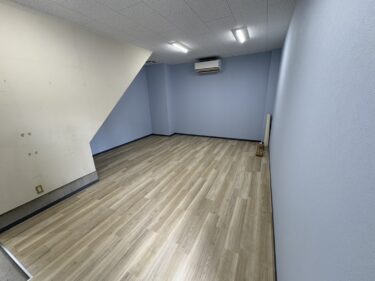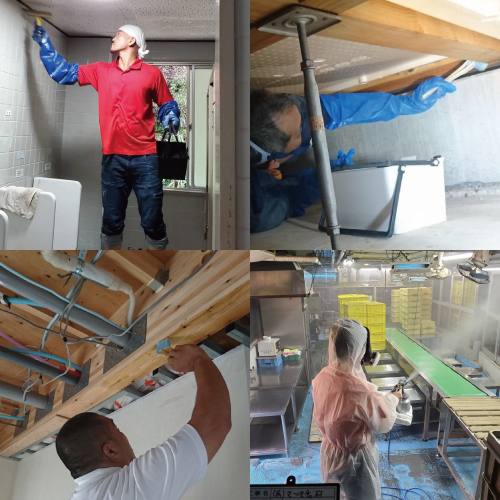1. Causes of Mold Growth in Vacant and Second Homes
Vacant homes and second residences are more susceptible to mold growth because they are unoccupied for long periods, leading to poor ventilation and trapped humidity. Especially in areas like Ashiya, Tezukayama, and Kurakuen, the natural environment contributes to higher humidity levels, and highly airtight homes further create ideal conditions for mold.
1-1. The “Golden Combo” of Humidity and Temperature
Mold thrives under specific conditions—mainly the combination of humidity and temperature. When temperatures range between 20°C to 30°C and humidity exceeds 70%, mold growth accelerates rapidly. In vacant homes without air conditioning or airflow, this threshold is easily reached. Even short periods of absence can result in significant mold formation due to these ideal environmental factors.
1-2. Lack of Ventilation, Natural Surroundings, and Dust Accumulation
Poor ventilation allows humidity to build up in closed spaces such as closets, under floors, and behind furniture. Natural elements from nearby mountains or seas also contribute to elevated indoor moisture levels. Dust accumulation acts as a food source for mold, making uncleaned homes particularly vulnerable. Even invisible dust particles can feed mold growth in moist conditions.
2. How Absenteeism and Neglect Invite Mold
Leaving a home unattended, especially for extended periods, creates a perfect environment for hidden deterioration—most notably, mold formation. During rainy seasons or typhoons, humidity increases, allowing mold to spread quickly.
2-1. Trapped Humidity and Condensation in Closed Homes
When all windows and doors are shut, natural ventilation stops completely. This causes humidity to remain inside, and condensation often forms due to temperature differences between inside and outside air. Areas like window sills, storage spaces, and behind cabinets become particularly prone to mold due to moisture accumulation.
2-2. Hidden Damage that Affects Property Value
Mold can weaken building materials, cause discoloration, and significantly reduce a property’s value. Especially for properties intended for sale or rent, such deterioration can lower appraisal prices. Preventing mold through regular maintenance is essential to maintaining real estate value.
3. Mold Issues in High-End Residential Areas like Ashiya, Tezukayama, and Kurakuen
Second homes in luxury neighborhoods, although spacious and well-equipped, can suffer from poor maintenance due to their infrequent use. This makes them prone to mold and unpleasant odors.
3-1. Mold Risks in Airtight Modern Homes
Modern upscale homes are built with high airtightness and insulation. While this ensures a comfortable environment, it also restricts airflow. Without running HVAC systems or ventilation during periods of vacancy, moisture and condensation accumulate—an ideal scenario for mold growth.
3-2. Odors, Health Hazards, and Neighbor Disturbance
Mold releases a distinct, musty smell that clings to walls, furniture, and fabrics. It also disperses spores into the air, which can trigger allergies, asthma, or skin irritation. This is especially concerning for children and elderly residents. In some cases, mold-related odors and insect infestations can even affect neighboring homes.
4. Basic Mold Prevention Tips You Should Know
Preventive measures, though simple, can significantly reduce the risk of mold in vacant properties. By implementing effective practices in advance, homeowners can protect their properties from mold-related damage.
4-1. Scheduled Ventilation, Dehumidifiers, and Window Management
Regular ventilation is the most effective defense against mold. Opening windows and letting fresh air circulate reduces humidity and prevents condensation. Installing a dehumidifier with a timer function is also highly effective, especially during rainy seasons. Ventilated window designs can further support airflow even while the property is unoccupied.
4-2. Cleaning, Moisture Removal, and Air Circulation Spaces
Dust and debris feed mold, so frequent cleaning—especially in moisture-prone areas like behind furniture and inside closets—is essential. Avoid placing furniture directly against walls to ensure airflow. Use slatted bases or spacers under storage boxes to maintain ventilation under furniture.
5. Room-Specific Care: Bathrooms, Kitchens, and Furniture
Some parts of the home are more mold-prone than others, particularly areas with frequent water use or poor ventilation. Tailored care for each space can reduce mold risks significantly.
5-1. Special Attention for Water-Prone Areas
Bathrooms and kitchens are prime spots for mold due to constant moisture. After using the bathroom, wipe surfaces and keep the ventilation fan running. Clean drains and dry walls thoroughly. In kitchens, ensure cabinets under sinks stay dry and install moisture absorbers in high-risk spots.
5-2. Improving Airflow Behind Furniture and in Closets
Poor airflow behind furniture and in closets creates mold hot spots. Leave a gap of at least 5cm between walls and furniture. Use moisture absorbers inside closets and space out stored clothes to encourage circulation.
6. Professional Mold Removal with the MIST Method
When mold has taken root, DIY sprays may not be enough. That’s where professional services like the MIST Method come in—an advanced solution for mold removal.
6-1. Eliminating Mold from the Root without Damaging Materials
The MIST Method uses customized agents suited for different surfaces, removing deeply embedded mold without damaging delicate materials. Unlike abrasive cleaning or power washing, it avoids sanding or scrubbing, preserving the original structure of wood or plaster walls.
6-2. Safe and Long-Lasting Mold Protection
The specially formulated MIST agents are safe for use in homes with children or seniors. After mold removal, a protective anti-mold coating is applied to prevent recurrence. This treatment is long-lasting and also eliminates airborne mold spores, providing complete environmental protection.
7. Property Management and Cleaning Services During Absence
For absentee owners, professional property management and cleaning services are vital. These services keep properties mold-free and well-maintained.
7-1. Services Offering Ventilation, Water Flushing, and Inspections
Management companies offer periodic visits for ventilation, flushing water lines, and checking indoor conditions. These simple actions help prevent humidity buildup and plumbing-related odors, keeping the home livable even during long absences.
7-2. How to Choose a Reliable Management Service
When selecting a provider, look for detailed inspection plans, local availability, and photo-based reporting. Most services range between ¥5,000 to ¥15,000 per month. Request quotes from multiple providers to find the best fit for your property and budget.
8. Ensuring Odors Don’t Return: Aftercare for Mold Prevention
Even after mold removal, without proper aftercare, it can return. This is why post-treatment steps are critical, especially for odor elimination.
8-1. Long-Lasting Protection with Anti-Mold Coatings
Professional mold services apply anti-mold sprays that coat all surfaces, including walls, floors, and hard-to-reach areas. The mist application ensures deep coverage, preventing new mold colonies from forming. These agents are designed to be effective against airborne spores and maintain cleanliness for months.
9. Consider Property Maintenance, Resale, or Repurposing
Mold issues can hurt property value, making resale or rental difficult. Proper maintenance is vital for asset preservation.
9-1. Risks of Value Loss from Neglect
A neglected vacant home deteriorates quickly. Mold, rot, and musty odors lower property appraisal and increase renovation costs. Preventative care ensures your asset remains an asset—not a liability.
9-2. Cleaning Strategies for Future Sale or Rental
If you plan to sell or rent the property, thorough cleaning and mold-proofing make a positive impression. A clean, odor-free home is more appealing and can increase resale value significantly.
10. Regional Tips for Ashiya, Tezukayama, and Kurakuen Residents
These luxury neighborhoods have unique environmental characteristics, requiring tailored mold prevention.
10-1. Terrain-Specific Humidity Risks from Sea and Mountains
Ashiya’s proximity to both the sea and mountains creates fluctuating humidity and temperature. Mountain areas see more condensation, while sea air introduces salty moisture that can damage building materials. Understanding local risks is key to prevention.
10-2. Local Contractors and Municipal Support Programs
Municipalities like Ashiya offer support programs for vacant house management and disaster readiness. Partnering with local specialists who understand regional climates ensures safer and more effective mold control.





